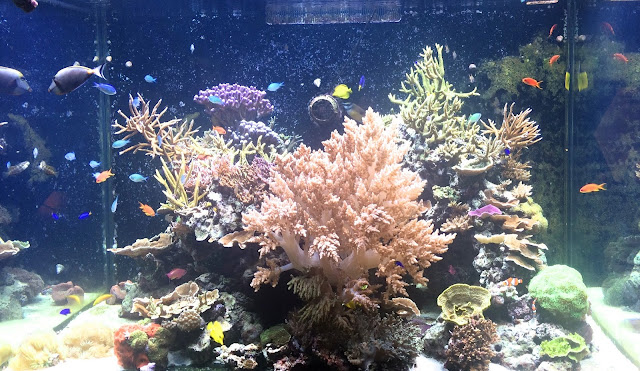Exhibition name: Coral Reefs - Secret Cities of the Sea
Where: Natural History Museum, South Kensington, London
Open: 27th March-15th September 2015
Visited: 28th July 2015
Paid: £10 (£4.50 for concessions)
When I saw that a coral reefs exhibition had opened this year at the Natural History Museum in London, I knew it needed to be paid a visit! The Natural History Museum is somewhere I certainly remember loving to visit as a little, hyper and overexcited child, enthralled by the dinosaurs. The museum is wonderful as it is free to enter the main building (donations accepted) and then you can choose to pay a fee if you wish to visit special exhibitions like that of Coral Reefs.
 |
| Lots of samples of coral and sea creatures |
I was immensely pleased with what the exhibition had to offer. It catered for both the old-fashioned exhibition-goers and also those who love interactive and visual learning. A vast amount of the information on show was similar to what we had learnt in our marine biology lectures during our biology degree. This shows how much you can learn from visiting an exhibition like this.
 |
My favourite part of the exhibition was the brightly-coloured fish tank full of a plethora of coral and fish species (see photo below). It was beautiful, even with the 'reef' being housed in an electronically lit up tank in the middle of London! Next to the tank, it was great to see a sign stating that all creatures seen were 'sourced sustainably, confiscated by UK customs or from coral research tanks at the Horniman Museum and Gardens'. This shows that they are taking care to look after the environment as well as educating the public about the problems facing coral reefs.
 |
| The exhibition's beautiful coral reef tank |
The exhibition spoke about how many coral reefs are experiencing a change from mainly coral species to algae and seaweed. In our lectures we heard about this being named 'the slippery slope to slime'. This can be seen as an indirect effect of overfishing, as if the abundances of certain fish species reduce, the amount of grazing of algae on coral reefs will also decline dramatically. This means that algae can become more and more abundant and begin to smother corals.
This is something that many people will not think about when they hear about a rise in the prevalence of overfishing. But, this 'slippery slope to slime' is a reason that we must be careful how we fish, how much we fish and where we fish in order to prevent the imminent decline of beautiful underwater coral 'cities' across the world's oceans.
Overall, I definitely believe this exhibition is worth a visit. The only drawback is that it is quite a short but sweet exhibition. I however do not think that this is a problem as there are copious other parts of the Natural History Museum to explore once you have finished learning about coral!










